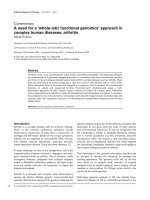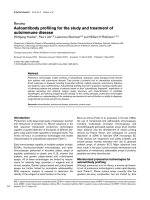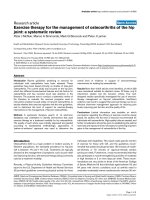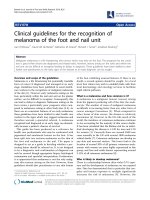Báo cáo y học: "Transthoracic echocardiography for the diagnosis of left ventricular thrombosis in the postoperative care unit" ppt
Bạn đang xem bản rút gọn của tài liệu. Xem và tải ngay bản đầy đủ của tài liệu tại đây (251.87 KB, 5 trang )
RESEARCH Open Access
Transthoracic echocardiography for the diagnosis
of left ventricular thrombosis in the postoperative
care unit
Theodosios Saranteas
1*
, Anastasia Alevizou
1
, Maria Tzoufi
1
, Fotios Panou
2
, Georgia Kostopanagiotou
1
Abstract
Introduction: Transthoracic echocardiography (TTE) is a reliable, noninvasive imaging method that is useful in the
evaluation of cardiovascular thrombosis. We conducted a retrospective study of all the echocardiograms from
patients in the postoperative care unit to assess the role of TTE in thrombus identification in the left ventricle.
Methods: This retrospective database evaluation included all echocardiograms during a 14-month period. The
echocardiographic examination pro tocol included the subcostal four-chamber view, the apical four-chamber view,
the apical two-chamber view and the parasternal view, along the long and short axes in both spontaneously and
mechanically ventilated patients. All echocardiograms wer e obtained within the 48 hours immediately following
surgery.
Results: In total, 160 postoperative echocardiograms were obtained from 160 patients and resulted in the
detection of five cases of left ventricular thrombosis. Subgroup analysis showed that 21 and 35 of the 160 patients
examined had either dilated or ischemic cardiomyopathy, respectively. In these patients, preoperative
echocardiograms had been obtained recently prior to surgery and were negative for left ventricular thrombus. In
three of 35 patients with ischemic cardiomyopathy and two of 21 patients with dilated cardiomyopathy, thrombus
was identified in the left ventricle. The thrombi were mobile, uncalcified and pedunculated and were located in
the apex of the left ventricle. In addition, no clinical consequences of the left ventricular thrombi were recorded.
Conclusions: Low-flow conditions in heart chambers due to ischemic or dilated cardiomyopathy in conjunction
with the hypercoagulability caused by perioperative prothrombotic factors may lead to thrombotic events in the
left ventricle.
Introduction
Both transesophageal echocardiography (TEE) and trans-
thoracic echocardiography (TTE) can identify the cause
of shock and other lesions in the setting of the intensive
care unit (ICU). Echocardiography can significantl y alter
the management of up to 46% of critically ill patients
[1-4]. TTE also offers a noninvasive way to evaluate car-
diac function. Traditionally, this role has been performed
solely by cardiologists with extensive training in advanced
TTE techniques. However, a growing body o f evidence
points to the ability of noncardiologist intensivists to
employ TTE in the ICU setting [5-8]. Anesthesiologists
with a cardiac and echocardiography background can
successfully perform TTE in almost all patients when
necessary, and they typically provide valuable diagnostic
information of critical importance [9-11]. Recently, Jensen
et al. [9] have advocated the position that TTE is the
onl y technique that provid es dynamic real-time bedside
imaging of the heart. At least one usable window for car-
diac imaging can be obtained in 97% of a mixed ICU
population, and TTE results contribute conclusive infor-
mation in 25% of these cases [9].
In addition, focused ultrasonography has emerged as
an important and noninvasive bedside diagnostic tool
for the emergency room physician that facilitates the
early detect ion of potentially reversible and time-depen-
dent conditions. Currently, the two primary indications
* Correspondence:
1
Department of Anaesthesia and Cardiovascular Critical Care, Medical School,
University of Athens, Attikon Hospital of Athens, Haidari, Rimini Str 1, 12462,
Haidari, Athens, Greece
Full list of author information is available at the end of the article
Saranteas et al. Critical Care 2011, 15:R54
/>© 2011 Saranteas et al.; licensee BioMed Central Ltd. This is an open access article distributed under the terms of the Creative
Commons Attribution License ( which permits unrestricted use , distribution, and
reproduction in any medium, provided the original work is properly c ited.
for TTE are the diagnosis of pericardial tampo nade and
the confirmation or refutation of pulseless electrical
activity [8].
In this retrospective study, we report our experience
using TTE for thrombus identification in the left ventri-
cle in the setting of a postoperative care unit.
Materials and methods
We conducted a retrospective study o f all echo cardio-
gramsfrompatientsinthepostoperativecareunitto
ass ess the role of TTE in thro mbus ident ification in the
left ventricle during the postoperative period. The post-
operative care unit receives both elective and emergency
admissions from a wide range of surgical specialties,
including major vascular, thoracic, abdominal and
orthopedic surgery.
Because of the retrospective design of t he study, for-
mal research ethics committee approval and patients’
written informed consent for publication of this manu-
script and accompanying images were deemed unneces-
sary after consultation with the local ethics committee.
A retrospective database evaluation was undertaken
for all echocardiograms obtained during a selected 14-
month period. All echocardiograms examined were part
of a specific echocardiographic protocol that is per-
formed as a local standard of care for typical postopera-
tive indications, including evaluation of left and right
ventricular function, hypotension, pulmonary edema,
diagnosis of pericardial effusion, suspected valvular dis-
ease and refractory hypoxia.
A competent anesthetist consultant who was undertak-
ing European Society of Echocardiography accreditation
performed the TTE studies. Hand-carried ultrasound
examinations were conducted using a 2- to 5-MHz
phased array transducer on a portable ultrasound unit
(Vivid I; GE Healthcare, Waukesha, Wisconsin, USA).
The echocardiographic examination protocol included
visualization of the subcostal four-chamber view, the
apical four-chamber view, the apical two-chamber view
and the parasternal long-axis and short-axis views in
either spontaneously breathing or mechanically venti-
lated patients.
All results were digitally archived to permit peer
review, and consultant cardiologists reviewed ambiguous
results.
Results
All echocardiography was performed within the 48 hours
immediately following surgery. During the 14-month per-
iod, 160 postoperative echocardiograms were obtained
from 160 patient s (85 females and 75 males) who had a
median age of 67 years and who ranged in age from 20
to 89 years. In total, 125 of the 160 patients were sponta-
neously breathing, whereas the remaining 35 patients
were under mechanical ventilation. The echocardiograms
were obtained from patients who had undergone the fol-
lowing operations: major thoracic (10 patients), orthope-
dic (40 patients), vascular (35 patients) or abdominal
(75 patients). In 45 of the 75 abdominal operations, the
incision was in or extended into the upper abdomen.
Five of 160 patients were found to have masses consis-
tent with thrombi in the left ventricle. All of the
thrombi were detec ted in t he acute setting when TTE
was performed and, specifically, were identified in the
left ventricular apex. Table 1 shows the characteristics
and findings for these five patients.
Clear visualization of the thrombi was observed in the
apical four-chamber view, the apical two-chamber view
and the parasternal short-axis view. In one of the cases,
the thrombus was also visualized in the parasternal
long-axis view (Figure 1). Further examination revealed
that the thrombi were mobile, uncalcified, pedunculated
and protruding into the left ventricle.
Subgroup analysis showed that 21 and 35 of 160
patients examined had dilated and ischemic cardio myo-
pathy, respecti vely. In these patients, preoperative echo-
cardiograms had been obtained recently prior to surgery
and were negative for left ventricular thrombus. In 3
(8.5%) of 35 patients with ischemic cardiomyopathy and
2 (9.52%) of 21 patients with dilated cardiomyopathy,
thrombus was identified in the left ventricle (Figure 2).
In addition, we did not observe any clinical conse-
quences related with the left ventricular thrombi, that is,
thromboembolic events.
After diagnosis of thrombus in the left ventricle, full
anticoagulant treatment with low-molecular-weight
heparin was started.
Discussion
Cardiovascular thrombosis is co mmon in the ICU set-
ting because critically ill patients are immobile and
sedated, exposed to thrombin-generating procedures
(for example, central venous catheterization) and fre-
quently have other t hrombotic risk factors (for example,
malignancies or trauma) [12,13].
Patients at risk for the development of a left ventricu-
lar thrombus are readily identified with echocardiogra-
phy. Thrombi generally involve the apex of the left
ventricle, most often in the presence of akinesis or dys-
kinesis. Although myocardial infarction is the most
common predisposing cause of left ventricular thrombi,
left ventricular thrombi can develop in any situation in
which low flow occurs [14].
In our study, all of the left ventricular thrombi were
detected in the acute setting when TTE was performed
immediately after surgery for hemodynamic monitoring
purposes. In the left ventricle, thrombi were located
only at the cardiac apex. Ischemic cardiomyopathy in
Saranteas et al. Critical Care 2011, 15:R54
/>Page 2 of 5
Table 1 Patient characteristics
a
Patients Type of
ventilation
Type of surgery Cardiac pathology Thrombus
location
1 SB Vascular surgery (axillary-femoral artery
bypass)
Dilated cardiomyopathy EF = 25% Left ventricle
2 SB Vascular surgery (aneurysm of the
abdominal aorta)
Dilated cardiomyopathy EF = 25% Left ventricle
3 MV Abdominal surgery (ischemic colitis-
bowel resection)
Anterior myocardial infarction, ischemic cardiomyopathy:
EF = 35%
Left ventricle
4 MV Abdominal surgery (cancer, bowel
perforation)
Anterior myocardial infarction, ischemic cardiomyopathy
EF = 30%
Left ventricle
5 MV Abdominal surgery (cancer, bowel
perforation)
Anterior-posterior myocardial infarction, ischemic
cardiomyopathy EF = 30%
Left ventricle
a
SB, spontaneous breathing; MV, mechanical ventilation; EF, ejection fraction.
Figure 1 Transthoracic echocardiog raphy of the left ven tricle. Thrombus (arrows) in the apex of the lef t ventricle is clearly depicted in the
(A) short, (B) long parasternal axes as well as in the (C) apical four-chamber and in the (D) apical two-chamber views.
Saranteas et al. Critical Care 2011, 15:R54
/>Page 3 of 5
three patients and dilated c ardiomyopathy in two
patients may have contributed to this thrombus forma-
tion [14]. Although all of our patients showed increased
procoagulant activity, it was generally difficult to explain
the origin of the cardiovascular thrombi. The nature of
the thrombi (soft, mobile and uncalcified, forming a
mass along the akinetic and/or dyskinetic cardiac wall),
along with the negative left ventricular thrombus find-
ings on pr eoperative echocardiograms, led to t he con-
clusion that the thrombi were formed during the
perioperative period and that perioperative prothrombo-
tic factors together with the patients’ prothrombotic
substrates contributed to the thrombotic events. More
specifically, in our patients, low-flow conditions due to
ischemic or dilated cardiomyopathy [14] in conjunction
with the hypercoagulability caused by surgical trauma
[15] and/or cancer [16] might have contributed to left
ventricular thrombosis.
Although surgical pa tie nts may h ave absolute contra-
indications for anticoagulant therapy immediately after
surgery, it is not well known whether the nature, quality
and presence of thrombus represent an absolute indica-
tion for full-dose anticoagulant treatment. In our cases,
TTE revealed an uncalcified, fresh and extensively
mobile structure in the apex of the left ventricl e. There-
fore, full-dose anticoagulant therapy was considered
indispensable in avoiding the consequence s of thrombus
dislodgement into the bloodstream.
The sensitivity of TTE for detecting left ventricular
thrombosis ranges between 92% and 95%, with specifi-
city of 86% to 88% [17]. On the contrary, in T EE, mide-
sophageal apical planes did not place the left ventricular
apex in the near field, whi ch is opt imal for this purpose;
transgastric views cannot always be obtained, especially
in awake patients, and are often of low quality [18,19].
In TTE, large, protruding and highly mobile thrombi
are readily seen from the apical window, while laminar
thrombi that do not protrude into the cavity are likely to
be missed [20]. Poor imaging quality also reduces the
accuracy of thrombus identification and may produce
both false-negative and false-positive results. An addi-
tional method of confirming the presence or absence of
left ventricular t hrombosis, especially in cases of poor
imaging quality, is to use contrast enhancement for left
ventricular opacification [21]. In our five patients, there
was excellent delineation of the left ventricular cavity and
clear depiction of the ventricular apical thrombus. In
addition, vague results were thoroughly examined by con-
sultant cardiologists, competent in TTE, who deemed the
use of ultrasound contrast agents unnecessary.
In our study, thrombi in the left ventricle were mainly
identified in the apical four-chamber view and by scan-
ning the apex in t he short-axis paras ternal view. Using
the long-axis parasternal view, only one case of left ven-
tricle thrombosis was recognized. From this view, it was
not always possible to visualize the left ventricular apex.
Indeed, only when the transducer is moved to a lower
interspace is the left ventricular apex included in the
field [22]. Among our patients, a view of the left ventri-
cular apex was obtained only with difficulty by using the
long-axis parasternal view because of the fact that our
patients were always supine and could not be moved
into the left lateral decubitus position.
In addition, left ventricular thrombi could not be seen
using the subcostal view. In the first, second and third
patients, the main reasons were t echnical limitations
related to foreshortening and to the inability to visualize
the left ventricular apex from the subcostal view because
of the position of the transducer relative to the cardiac
apex [22,23]. In the fourth and fifth patients, extension
of the surgical incision into the upper abdomen made it
impossible to record this view.
Figure 2 Transthoracic echocardiography of the left ventricle.
Thrombus (arrows) in the apex of the left ventricle in (A) patients
with ischemic cardiomyopathy and (B) patients with dilated
cardiomyopathy.
Saranteas et al. Critical Care 2011, 15:R54
/>Page 4 of 5
Study limitations
Although this study is retrospectively designed, our
observations offer important information in an other-
wise unknown topic such as that of left ventricular
thrombosis in surgical patients; hence, the hypothesis of
the high rates of left ventricular thrombi in surgical
patients with either ischemic or dilated cardiomyopathy
remains to be confirmed in a prospective study.
Conclusions
There is clear value in using TTE imaging of the heart
for the purpose of cardiovascular evaluation and optimi-
zation in the postoperative period. This report demon-
strates that information gained from TTE imaging
contributes to the correct diagnosis of cardiovascular
thrombosis in patients in the acute postoperative setting
who have either dilated or ischemic cardiomyopathy.
Key messages
• TTE can provide serendipitous informatio n in cri-
tical care patients and could also facilitate the diag-
nosis of systemic or local disorders.
• Low-flow conditions in the heart chambers due to
ischemic or dilated cardiomyopathy in conjunction
with the hypercoagulability caused by surgical trauma
and/or cancer may lead to left ventricular thrombosis
during the perioperative period. The thrombi formed
were located in the left ventricular apex and were
mainly depicted in the apical four- and two-chamber
views as well as in the parasternal short-axis view.
Abbreviations
ICU: intensive care unit; TEE: transesophageal echocardiography; TTE:
transthoracic echocardiography.
Author details
1
Department of Anaesthesia and Cardiovascular Critical Care, Medical School,
University of Athens, Attikon Hospital of Athens, Haidari, Rimini Str 1, 12462,
Haidari, Athens, Greece.
2
Department of Cardiology, Medical School,
University of Athens, Attikon Hospital of Athens, Haidari, Rimini Str 1, 12462,
Haidari, Athens, Greece.
Authors’ contributions
TS conceived of the study and performed all the echocardiography. AA
provided analysis of ultrasound imaging data and drafted the manuscript.
MT reviewed and archived ultrasound data. FP provided expert
echocardiographic consulting. GK participated in the design of the study.
Competing interests
The authors declare that they have no competing interests.
Received: 2 July 2010 Revised: 26 November 2010
Accepted: 9 February 2011 Published: 9 February 2011
References
1. Stanko LK, Jacobsohn E, Tam JW, De Wet CJ, Avidan M: Transthoracic
echocardiography: impact on diagnosis and management in tertiary
intensive care units. Anaesth Intensive Care 2005, 33:492-496.
2. Vignon P, Mentec H, Terre S, Gastinne H, Gueret P, Lemaire F: Diagnostic
accuracy and therapeutic impact of transthoracic and transoesophageal
echocardiography in mechanically ventilated patients. Chest 1994,
106:1829-1834.
3. Colreavy FB, Donovan K, Lee KY, Weekes J: Transoesophageal
echocardiography in critically ill patients. Crit Care Med 2002, 30:989-996.
4. Karabinis A, Saranteas T, Karakitsos D, Lichtenstein D, Poularas J, Yang C,
Stefanadis C: The ‘cardiac-lung mass’ artifact: an echocardiographic sign
of lung atelectasis and/or pleural effusion. Crit Care 2008, 12:R122.
5. Beaulieu Y: Specific skill set and goals of focused echocardiography for
critical care clinicians. Crit Care Med 2007, 35:S144-S149.
6. Beaulieu Y: Bedside echocardiography in the assessment of the critically
ill. Crit Care Med 2007, 35:S235-S249.
7. Saranteas T, Christodoulaki K, Rinaki D, Kostopanagiotou G: Transthoracic
echocardiography for the identification of acute aortic regurgitation in
the intensive care unit. J Cardiothorac Vasc Anesth 2011, 25:204-205.
8. American College of Emergency Physicians: ACEP emergency ultrasound
guidelines-2001. Ann Emerg Med 2001, 38:470-481.
9. Jensen MB, Sloth E, Larsen KM, Schmidt MB: Transthoracic
echocardiography for cardio-pulmonary monitoring in intensive care. Eur
J Anaesthesiol 2004, 21:700-707.
10. Price S, Nicol E, Gibson DG, Evans TW: Echocardiography in the critical ill:
current and potential roles. Intensive Care Med 2006, 32:48-59.
11. Cowie B: Focused cardiovascular ultrasound performed by
anesthesiologists in the perioperative period: feasible and alters patient
management. J Cardiothorac Vasc Anesth 2009, 23:450-456.
12. Crowther MA, Cook DJ, Griffith LE, Devereaux PJ, Rabbat CC, Clarke FJ,
Hoad N, McDonald E, Meade MO, Guyatt GH, Geerts WH, Wells PS: Deep
venous thrombosis: clinically silent in the intensive care unit. J Crit Care
2005, 20:334-340.
13. Saranteas T, Mandila C, Poularas J, Papanikolaou J, Patriankos A,
Karakitsos D, Karabinis A: Transesophageal echocardiography and vascular
ultrasound in the diagnosis of catheter-related persistent left superior
vena cava thrombosis. Eur J Echocardiogr 2009, 10:452-455.
14. Feigenbaum H: ICU and operative/perioperative applications. In
Feigenbaum’s Echocardiography. 6 edition. Edited by: Feigenbaum H,
Armstrong WF, Ryan T. Philadelphia: Lippincott Williams 2005:710-725.
15. Meissner MH, Chandler WL, Elliott JS: Venous thromboembolism in
trauma: a local manifestation of systemic hypercoagulability? J Trauma
2003, 54:224-231.
16. Baron J, Gridley G, Weiderpass E, Nyren O, Linet M: Venous
thromboembolism and cancer. Lancet 1998, 351:1077-1080.
17. Otto C: Cardiac masses and potential cardiac ‘sources of embolus’. In
Textbook of Clinical Echocardiography. 3 edition. Edited by: Otto C.
Philadelphia: Elsevier-Saunders; 2004:416-418.
18. Feigenbaum H: The echocardiographic examination. In Feigenbaum’s
Echocardiography. 6 edition. Edited by: Feigenbaum H, Armstrong WF, Ryan
T. Philadelphia: Lippincott Williams 2005:131-134.
19. Mahmood F, Christie A, Matyal R: Transesophageal echocardiography and
noncardiac surgery. Semin Cardiothorac Vasc Anesth 2008, 12:265-289.
20. Hüttemann E: Transoesophageal echocardiography in critical care.
Minerva Anestesiol 2006, 72:891-913.
21. Siebelink HM, Scholte AJ, Van de Veire NR, Holman ER, Nucifora G, van der
Wall EE, Bax JJ: Value of contrast echocardiography for left ventricular
thrombus detection postinfarction and impact on antithrombotic
therapy. Coron Artery Dis 2009, 20:462-466.
22. Feigenbaum H: The echocardiographic examination. In Feigenbaum’s
Echocardiography. 6 edition. Edited by: Feigenbaum H, Armstrong WF, Ryan
T. Philadelphia: Lippincott Williams 2005:107-122.
23. Otto C: Transthoracic views, normal anatomy, and flow patterns. In
Textbook of Clinical Echocardiography. 3 edition. Edited by: Otto C.
Philadelphia: Elsevier-Saunders; 2004:30-51.
doi:10.1186/cc10025
Cite this article as: Saranteas et al.: Transthoracic echocardiography for
the diagnosis of left ventricular thrombosis in the postoperative care
unit. Critical Care 2011 15:R54.
Saranteas et al. Critical Care 2011, 15:R54
/>Page 5 of 5









